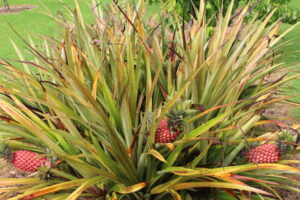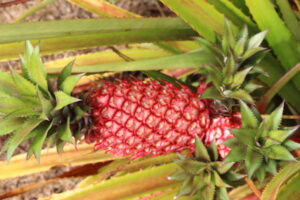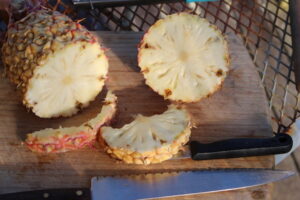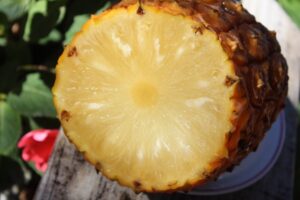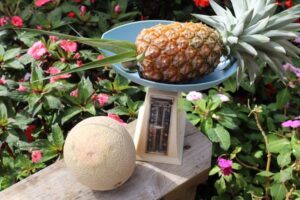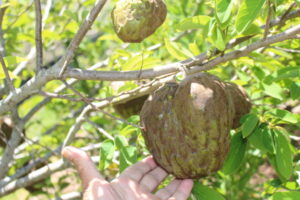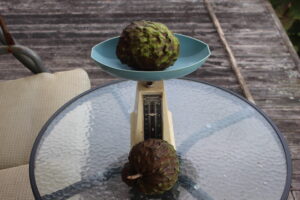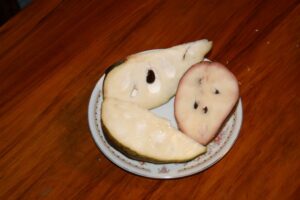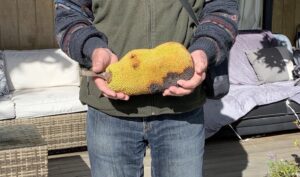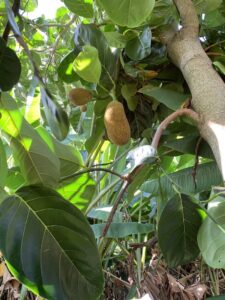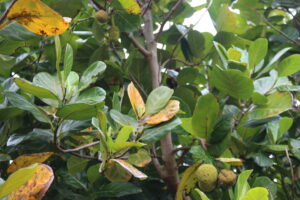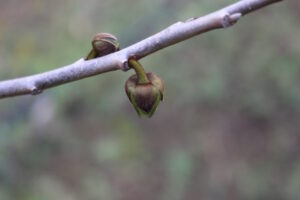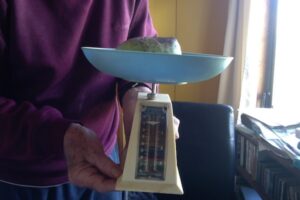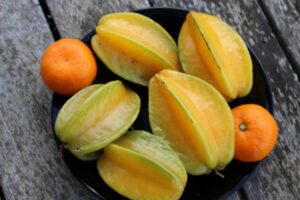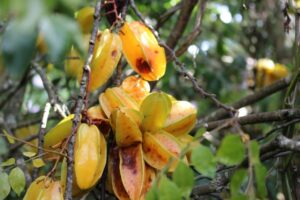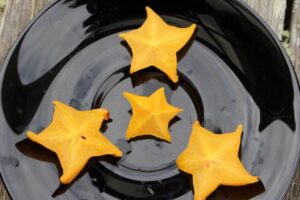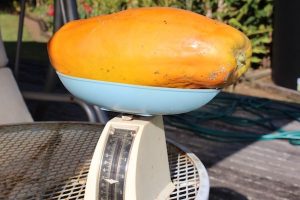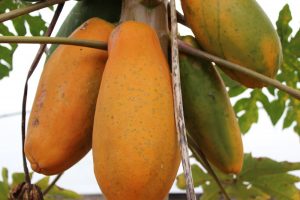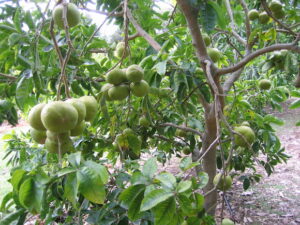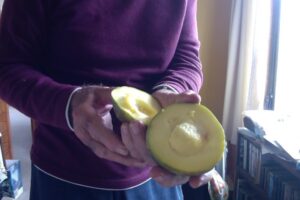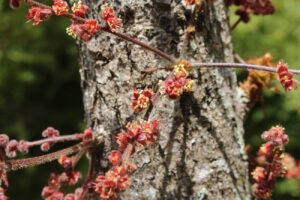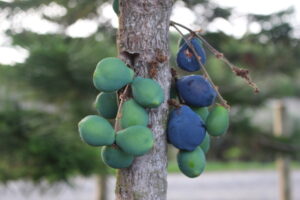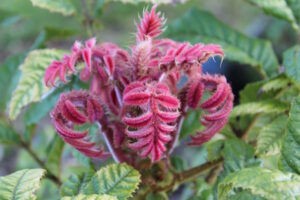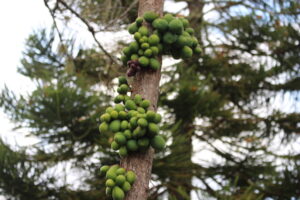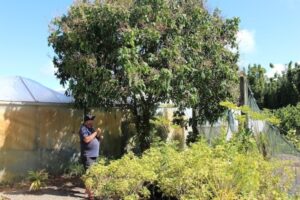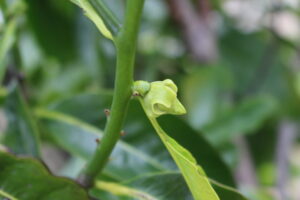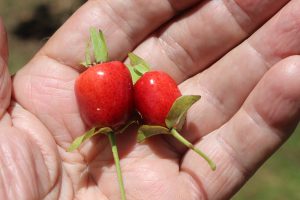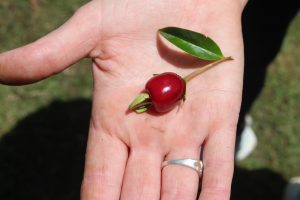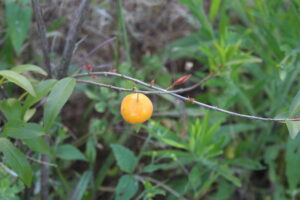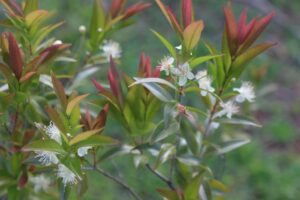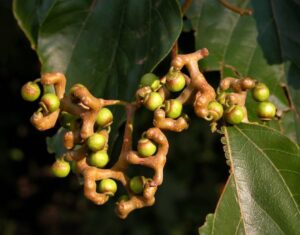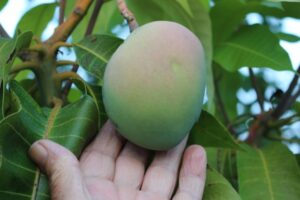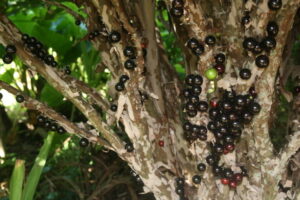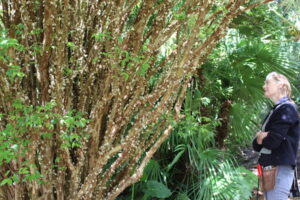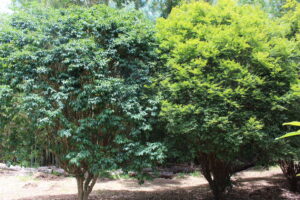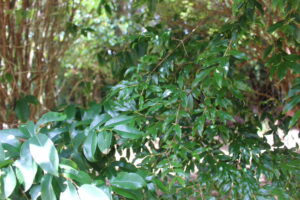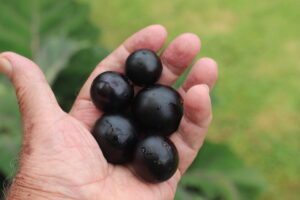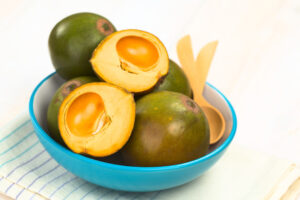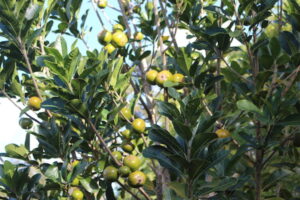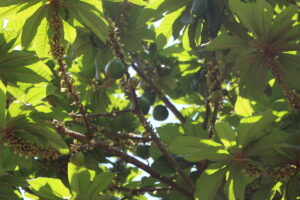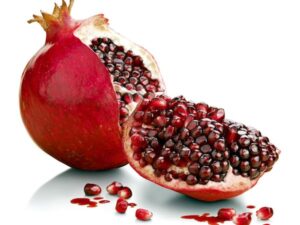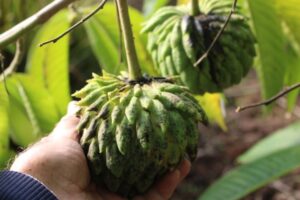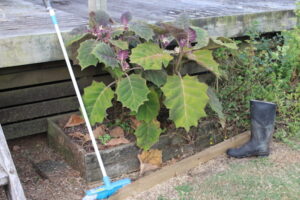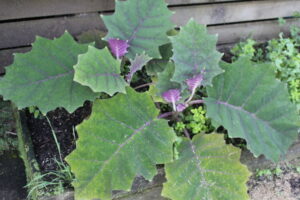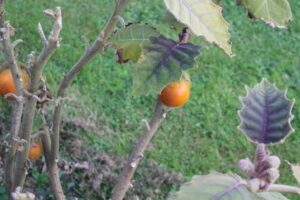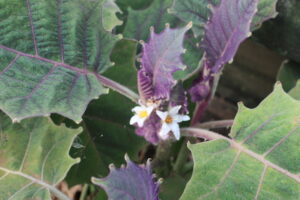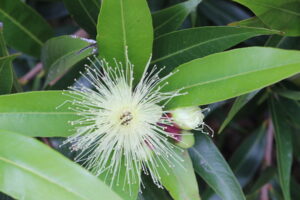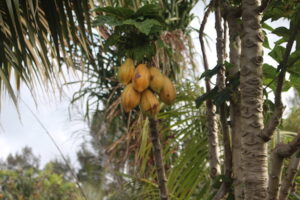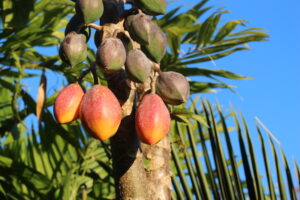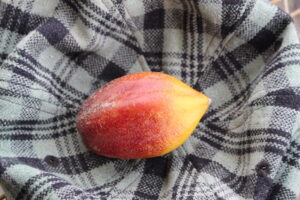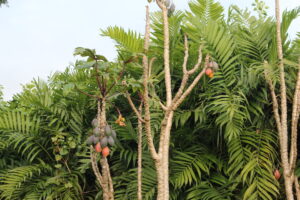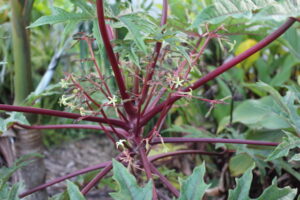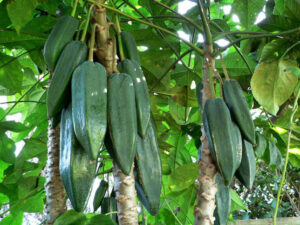All our exotic fruit plants below are listed alphabetically by their botanical (Latin) name. For those not familiar with the proper names, some popular species are to be found under the words in brackets in this list:
- Casimiroas (Casimiroa edulis)
- Cherimoyas (Annona cherimola)
- Guavas (Psidium guajava)
- Jaboticabas (Plinia cauliflora)
- Pineapples (Ananas spp.)
- White Sapotes (Casimiroa)
For availability and other details:
please enquire further — you can email me by clicking here. I used to sell many more types of fruiting plants than this, but in 2011 I downsized, and moved to a new property, where I sell some fruit plants, and hibiscus, mostly.
Note: all photographs in this section, and elsewhere, are from my own efforts to grow exotic fruit in Aotearoa/New Zealand (unless I note in the entry that I’ve had to source a useful photo from elsewhere. There’s very few of such pictures on this website. I really have been doing this sort of thing for 50 years and more!)
Ananas bracteatus
Pink-skinned Mountain Pineapple
These are hardy enough to grow outdoors in warm spots in NZ. They yield moderate sized pinkish skinned fruit which are fully edible and can be quite pleasant when fully ripe, albeit not at the level of the best commercial fruit. The leaves are edged with sharp protusions, so don’t plant them where, as they spread out with time a metre or so, they’ll be something you have to take care around when walking on paths. The first year we fruited them at South Kaipara Head we were eating about a fruit a week for several months. Our young children were still eating their share at the end of this time- and children can be picky, so this tells you something about their edibility if you are worried on this score! Not as good as the commercial pineapple species, but OK to eat, and just fine to look at as an ornamental.
Price: from $40, depending on size, up to about $80 .
In Stock? YES
Ananas bracteatus var. ‘Tricolor’
Variegated form of the Pink-skinned Mountain Pineapple
An even more spectacular form of this species. Eat these when the fruit turns yellow, and you can smell (Yum! Yum!) that they are ripe. The fruit will be somewhat smaller than the commercial fruit species, but still OK to try eating. Outdoors in warm and protected spots in northern New Zealand or indoors under plastic. About two years to fruiting, depending on growing conditions. Photographed under plastic at my place.
Price: from $45 each.
In Stock? NO
Ananas comosus
Pineapple
This is the species for commercial pineapples. Will fruit in a very protected spot (e.g. worth trying at the foot of a north facing brick or concrete block base), or very definitely in a plastic house, conservatory, or glasshouse. This was my third fruit after moving to the Far North. Eating quality can be absolutely excellent!
I produce plants for sale from my own fruit. Pineapples are not grown from seed (an impractically lengthy process for a nursery). I do not own a pineapple plantation in Hawaii, and most of my own relatively small number of plants are still young, and not producing fruit yet. This necessarily limits the number of plants that I can offer.
Price: from $45 each
In Stock? YES
Annona atemoya
Atemoya
Sometimes at South Head I offered these hybrids. Later, near Kerikeri, my two eldest (and differently sourced) atemoyas were coming into very heavy flowering as we went into 2014. By the end of January fruitlets were beginning to form, and 6 fruit were still being held in early September 2014 on one plant. The largest is in the photo. More fruit held on the tree in the next summer (2015-16), but the seeds did not germinate for me. Definitely a different flavour from that of cherimoya. The fruit in the second photo were blown off the tree in late November 2022, and needed more ripening before eating.
At times since I wrote the comments above I’ve wavered in my assessment of the eating quality. I now (since 2021) focus on the one remaining atemoya tree. Memory suggests that I got it from the Austen brothers near Kaitaia a long time ago, and that it is one of the main Australian varieties. It is grafted onto cherimoya understock. I’ve learned that the tree bears fruit in good numbers, and that they ripen after almost all of the cherimoya trees that I grow. I’ve checked with George Austen, and he agrees with my memory that this is almost certainly the atemoya variety called ‘Pink’s Mammoth’.
Atemoyas are hybrids of a cherimoya crossed with another member of the Annonaceae. They are very often hybrids of cherimoyas with the more heat demanding Annona squamosa. The latter is often referred to as “Sugar Apple”.
Price: $90, when available, as grafted plants.
In Stock? YES
Annona cherimola
Cherimoya
I have plants of ‘Canaria‘ back in stock, and also relatively new plants of ‘Bronceada‘. ‘Bronceada’ was about the best cherimoya we had access to back in the 1980s. A bit seedy by modern standards, but good flavour. A few grafted plants of cherimoyas from my orchard here are also available from time to time.
The mainstream cherimoyas are priced at a standard $65. My own favorite plants are $75 or more, when available.
Price: $65 for ‘Canaria’ or ‘Bronceada’. I also have plants of an earlier good local selection called ‘Burton’s Favourite’ at $65 as well.
Higher for some rarer varieties, when in stock.
A superb cool subtropical fruit. I have aimed to eventually sell several excellent cultivars that I favour. I expect from time to time to have plants to sell of ‘White’, a lovely sweet and smooth fleshed cultivar. We thought it was a truly excellent fruit to eat. “Too sweet! Too sweet” an Asian customer once said to me. My mind was going “Huh?? Wha’???”. A single customer, despite the old saying, is definitely capable of being quite wrong, by most people’s standards. ‘White’ is at top left in the photo [click on photos to enlarge them] of the three cherimoya segments.
Another nice cultivar with very good flesh-to-seed ratio is called ‘FE5’. It is the one without seeds showing at the bottom left of the plate. I am still assessing how well ‘Rosie’ will fruit here, but a couple of plants will very occasionally be available. It comes from the seeds of what was described as “a pink-fleshed Californian cherimoya”. I wonder about that. Our fruits at South Head were definitely red tinged, as they are here in the Far North, and the flavour was mildly, but distinctly, different. I wonder if it might be an interspecies cross, perhaps of something such as the Purple Sugar Apple with cherimoya. I’m just guessing. But the fruit were never big, and I will be watching with interest when it fruits here as pollinators are near it. And it is less robust than other cherimoyas in its growth habit. Which is why I began to think that it might be a hybrid of cherimoya with a smaller, but related, fruit, such as a purple sweetsop/Sugar Apple. Most fruits of this one on my current property are also smallish, but maybe better maturity and pollination helps, as there were also several mid sized fruit in January 2021.
Then there is the named plant that I was given by Dick Endt who knew a good deal about such fruits. It came from one of Dick and Annemarie’s collecting trips to South America. I’ve mildly changed his name for it, so that it is now ‘Behind the Outhouse’, and it is from one of the places they stayed at with local people. It’s another choice for those who want to try good, but uncommon, cherimoyas.
White $75; FE5 $85; Rosie $100 Behind the Outhouse $100
In stock? YES for the 4 varieties mentioned just above this.
Artocarpus heterophyllus
Jakfruit, Jackfruit
It’s tropical, but tolerates the subtropics, and has enormous fruit. Some selections can even go over 50kg per fruit at times! However don’t expect that size on any plants offered here. I’ve seen several flowering outdoors in northern NZ. They begin with male flowers, and that’s the stage I’d seen young trees at, including my own. I’d also read several references in recent years to people who had fruited them outdoors in Northland. Then in June 2022 I went to visit the Ruakaka region. I visited a small specialist nursery in the One Tree Point area, and was allowed to photograph a tree growing on deep peat soils near the sea. This was my first sighting of actual fruiting outdoors in Aotearoa.
A very warm location, or under cover, and it’s worth experimenting with. Some selections will accept very vigorous pruning to hold the tree down in size. These include “Golden Nugget”. Seedlings of this one were offered from February 2022. These sold out quickly.
Then, something special happened at my place late in 2022. For the previous couple of years I’d had flowering, but it was of male flowers only. One day Bob the Builder #2 was here (Robert Ruston). He likes plants, and is interested in building up his own collections on his property. He is also naturally observant. What he observed one day in November 2022 was that there was a young fruit, set at last! By Christmas 2022 it was being joined by others. That’s in the third photo above.
Price: In stock? NO
Asimina triloba
North American Pawpaw
One of the three best native fruits of the USA which have all attracted advocates of their commercial potential. A distant cherimoya relative, extremely cold hardy, but wanting a warm summer. I did have small seedlings from our good fruit. Superb flavour and aroma. I get a better idea of how the seedlings are doing in very late spring, or early summer at the end of December. The flowers are not showy [see buds in photo]. The fruit are often clustered into hands. A single one can be up to about half a kilo. Update on availability- I will announce here as soon as I have some plants available again. These are NOT plants that grow quickly!
Early 2021 update. Again, there is still a waiting list. And the plants are small;. I will supply some when they are properly in leaf. They don’t have to be in a heated situation in winter as they come from very cold winter locations. I used to sell these mostly 3 at a time. However, I’ve been doing a bit of reading, and the requirement for fruiting is not to do with having male and female plants. Two with a bit of genetic difference is the main demand that they make. I am producing these from my own two trees, which are fruiting well now, and seedlings from them should be OK together. My sources for my plants were rooted suckers from two of my very best fruiting trees on South Kaipara Head. In turn, my 80 or so seedlings on SKH were grown from imported seeds that came from several leading breeders in the US, and those seeds came from their trees which were first rate selections in their turn.
In mid to late summer 2021: I dug up in Spring some suckers from my heavier suckering plant of the two that I now grow. Most, but not all of them, appear to have established roots now (I was writing this bit on 27.12.21) and they are growing normally. With these you get a varying amount of wooden stem, and then the foliage on top. The seedlings certainly are not growing on hardwood as the sucker-derived plants are. Prices will vary with size, and will be more than the two year seedlings. You will need a seedling to go with a rooted sucker. The latter is identical to the parent plant, and it will get the required genetic variation for pollination by growing a seedling nearby. Later it proved to be more difficult than I expected to grow the 2021 suckers on to being good plants. I will announce it on here if I have success in the future.
Prices: 2nd year seedlings are $45 each, or 2 for $80, 3 for $120, and so on. More for older plants
Averrhoa carambola
Star Fruit
Very decorative when sliced thru (hence the name), and often rather sour to eat, although there are sweeter selections with pleasant, mild flavours. Has been fruited by several persons in NZ (the first two photos are in July 2015, midwinter, at Wharepuke in Kerikeri; local mandarins for scale). But remember, these are slow growers. Moreover some local seeds that I’ve tried didn’t germinate very well. At present (2024) I have seedlings of the cultivar called ‘Fwang Tung’. This is a prolific bearer and is regarded as having better than average flavour and relatively lower sourness.
Price: depending on size. Currently available, 3rd year seedling plants, from $60 to $120.
In stock? Yes
Carica papaya
Tropical Papaya; Pawpaw
Usually referred to in our part of the world, including Australia and Polynesia, as “Pawpaw”. This usage leads to interminable confusion with what is in the USA known as the US native “Pawpaw”. The latter is an utterly different fruit. [See Asimina triloba above.] I try to keep the two fruits quite distinct, and only refer to the full flavoured fruit of the American native plant as a “pawpaw”.
Tropical papaya is the large fruit that our supermarkets get from Australia, the Pacific, and perhaps elsewhere with warmer climates than ours. They are difficult to grow for a long time outdoors in New Zealand. Our winters and early spring weather is moist and colder than they are really comfortable with. Eventually they succumb to root or stem rots because the weather for months stresses them. I have tried building a large box above ground with about 600 to 700mm of soil and growing mix in the box for the papaya to be directly planted in, above the greater moisture and drainage problems likely to be found in the general garden or orchard areas. I’ve done grafting onto related species that will grow satisfactorily outside: for example, Mountain Pawpaw (Vasconcellea cundinamarcensis), and the Oak-leafed Papaya (Vasconcellea quercifolia). I’ve tried spraying the plants, grafted or not, with fungicidal sprays. Whatever I thought might succeed. Some of these I’d read about in overseas rare fruit magazines. It was all to no avail. The Kiwi weather triumphed: the plants eventually failed.
I’ve seen plants growing quite well outdoors and providing edible fruit in the Far North against the brick wall of a house, warmed by the sun, and under the eaves so there was some protection from winter rains and prevailing winds. This points the way to finding it easy to grow the fruit. You need a winter/spring (or all year) plastic or glass cover over them. They don’t even need to be totally enclosed. I know a resident in the Coopers Beach area with a three sided, completely roofed, and completely open on one side, structure. He was selling some fruit at his local weekend market, after he’d gorged himself of course.
All photos in this entry are from my own experiences at my current address.
I have plants of four mainstream Tropical Papayas available for you to try. The first one is claimed to normally begin flowering while still relatively small (up to a metre in height). The third one will begin probably a metre or more higher than that. Whatever you do, you are going to have to manage the plants under semi or full cover by pruning to hold the height down. I know somebody living in Kerikeri who sold fruit from his own 3m tall glasshouse, just with a sign on the grass verge outside. I recall that he was especially keen on ‘Red Lady’.
The available ones now, as from mid January 2023, are 1) Waimanalo Papaya 2) Mexican Papaya 3) Sunset Papaya
4) Strawberry Papaya. 5) Red Lady plants.
‘Waimanalo Papaya’ gets its name from a place in Hawaii where it’s from. It is a low bearing variety, and flowering should be occurring by the time it reaches a metre tall. You sometimes see it called “Waimanalo Dwarf Papaya” because it is not as tall as many other varieties, and it starts fruiting earlier in its life than they do. “Sunset’ is a good cultivar, with salmon-pink flesh. ‘Strawberry’ should have more intense colour also. There are many good reports of the well coloured “Red Lady” being an excellent fruit and performer. It also can start producing fruit with the flowering about a metre above the ground. The ones I grow under plastic in my big, unheated, plastic house, do start fruiting as suggested in the literature, at a low height. Important if you are going to be growing in a small plastic house without much headroom.
Price: from $40 each.
Casimiroa edulis
White Sapote or Ice Cream Fruit
So close to being a commercial fruit, with its smooth, light flesh. Before I moved in 2011 we had over 20 varieties growing, and often had several of them in stock. They fruit (variably) late March to early July.
‘Wiki Woo’ and ‘Mac’s Golden’, and also a few of ‘Yellow’, are the ones I settled on as my own choices. These are the three cultivars I brought north with me in 2011 to plant on a smaller property than I had before. We generally liked the mildly stronger taste of the yellow fleshed fruit. These are fine casimiroas in my view. I’ve got well over 30, now approaching 40, years of experience with these plants, including both growing and eating them with Rosemary Steele on South Kaipara Head, and selling them at weekend markets for years. ‘Wiki Woo’ was simply the best choice both Rosemary and I agreed. Remember, these pronouncements are matters of personal taste and experience. Others will differ.
Plants of ‘Mac’s Golden’ for sale by me are currently in stock. ‘Wiki Woo’ is plentiful, and available again. Note that all casimiroas I sell are grafted plants.
I also sometimes have a few each of some of the white fleshed fruits. People generally like these when they encounter them for the first time. Indeed, that’s true generally for people encountering casimiroa fruit for the first time. as research in California indicated.
I like flavour. For that reason I prefer yellow fleshed selections to the white. Personal taste. Others really like white ones, such as ‘Luke’. Very smooth flesh to eat with a spoon- hence some call it “Ice cream fruit”. That’s for the texture of the actual fruit , which you’d usually be eating with a spoon, rather than making your own ice cream from it. [And I used to make ice cream at home quite often, testing and trying our many different fruits as flavouring.]
Some casimiroa skins can be a little bitter; others are fully edible. Experiment!
You should also realize that these grow into trees, and are not small shrubs.
The photos are of inside part of a ‘Wiki Woo’ tree, and the close up indicates the relative evenness of the fruit size on this selection. It also can give a mild colour change on the skin when ripening.
Prices: ‘Luke’, $70; ‘Te Puna Selection’ $70; Both of these are widely acceptable white fleshed casimiroas.
‘Wiki Woo’ is $90; All these three cultivars are available as of October 2024.
‘Mac’s Golden’ is $80, and available again.
Cyphomandra casana
Casana

Another South American fruit in the same family as tamarillos. Dick and Anne-Marie Endt at Landsendt in the Waitakere Ranges in Auckland were the main people associated with introducing it, and they had hopes of promoting it as another of their South American plant introductions. This was some decades ago. Plants were grown and fruited successfully by others but it never quite took off as a potential commercial fruit in this country alongside the tamarillo (Cyphomandra betaceum). It needs much the same conditions and temperatures as tamarillos do. The taste is different from the more common latter plant and is usually readily accepted by people who know tamarillos. It’s a thinnish, yellow-skinned relative, but its size might well be improved as has occurred with the tamarillo which has had decades of cultivation, selection and deliberate breeding.
Usually a few in stock, from $50
Davidsonia jerseyana
Davidson’s Plum
A classic Australian bush tucker tree, greatly ornamental/interesting looking, striking when in fruit (which are very sour), and it makes a gloriously good ‘plum’ jam. Robin Booth at Wharepuke in Kerikeri once told me he thought it was the best jam of that type he’d ever eaten. More succinctly, a friend of Rosemary’s called it “orgasmic”. You decide!
Of course it’s not a plum in our usual sense, as its new growth shows very clearly. But European settlers often named fruits that were new to them after what they had grown up with and that reminded them of what they’d known.
Price: from $60, depending on size and age. Most of mine for sale are 2-3 years old.
Dimocarpus longana
Longan
A dull light brown colour on the ripe skin which, when peeled or squeezed, opens up to reveal a fruit very like its relative the Litchi/Lychee. The flesh is a bit drier than with Litchi, and has a flavour that is a bit different too. It will stand light frosts to about -2C once established, if it has to. It is not fully tropical, and does need a mild winter to do well plus a lengthy period of warmth. I fruited a seedling in my former location on South Kaipara Head. The photo is of a tree in the Far North at Lake Ngatu.
In stock? No
Diospyros digyna
Black Sapote; Chocolate Pudding Fruit
This subtropical fruit is like a grey-green skinned, dark brown fleshed, astringent persimmon. The leaves are beautifully shiny mid-green. It has been fruited in NZ here and there. Ours flowered at Nestlebrae South, but didn’t seem to want to set fruit. Seedlings only available. Here’s the first flower at my Far North location, Summer 2016-17. This species seems to flower quite well, but often doesn’t get fully pollinated. Only fruitlets have occurred on the trees I’ve owned on two different properties. We need selections that do set more easily in Aotearoa.
Price: $35 and more, by size.
In stock? NO (try me in early 2025)
Eugenia brasiliensis
Grumichama
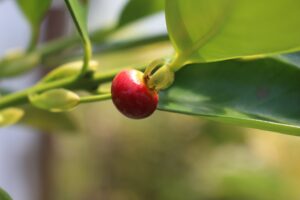
Occasionally I’ll have some of these for sale. I’m preferring Grumichama as a common name. It’s sometimes called Brazilian Cherry, but so are other plants, so I won’t use that to avoid confusion. Writers often praise the flavour, but all agree that it’s a minor fruit, and destined to remain that because of the small amount of flesh on each fruit. Here’s my first fruit (in December 2023). It’s under plastic, but the plant is more subtropical than tropical, and will cope with mild frost once established.
Price: $60 to $85 for my normal size; more for older ones, depending on size.
Eugenia involucrata (syn. E. aggregata)
Cherry of the Rio Grande
Not in stock now, but coming probably in early 2023. I think that everyone who I lived with on South Kaipara Head up till October 2011 ended up tasting this fruit before I did. Now that I managed to sample it in early 2022 I can say that in my experience of minor Eugenia fruits that this one clearly stands out with good eating quality that is definitely on a higher level than the others I’ve eaten. From southern Brazil, but naturally growing at some elevation so that it easily translates to growing in northern Aotearoa/New Zealand. They will set by themselves, but two plants should clearly increase the fruit load on these trees.
There were three of us talking while I took these photos. We all agreed at once that it would also visually make a great garnish for such things as a dessert, as well as tasting good.
Price: $70 to $100 for my normal size; more for older ones, depending on size.
Eugenia pyriformis
Uvalha; Uvaia
This interesting, but little known, fruit comes from a bit of elevation in Atlantic Rainforest Brazil. At 300 to 1,500m above sea level it’s out of the full tropical heat. It has some cool tolerance, and light frosts of 1 or 2 degrees are accepted by it once established. Well drained soils. Grows up to 8m, possibly less than that in NZ. Several fruit will fit comfortably into the palm of a hand. Seeds can now only come into Aotearoa via official inspections of the parent tree and with a phytosanitary certificate that it is free of the recently established disease of Myrtaceous plants. (We grow in Aotearoa lots of important introduced trees in this plant group.) Quite a quick grower from seeds. I can offer these fruit plants now as I had Uvalha fruiting on a former property. Pleasant sweet-acid taste in a smallish fruit, about the size of a medium/large plum. The fruit is high in antioxidants and Vitamin C. They have some aroma too.
(One photo from the internet; one with one fruit on a very young tree here; one of flowering in 2023 on one of my young trees)
Price: $60 to $85 for my normal size; more for older ones, depending on size.
In stock? NO
Eugenia uniflora
Surinam Cherry; Brazilian Cherry
The other names in the line above will tell you where it comes from. A small fruit, on a shrubby small tree, which is resistant to mild frosts once established. Eat when fully ripe. The little fruit will be deep red, or black, depending on selection, and will easily fall into the hand at that point. One source says to avoid eating the seeds, but I never personally noticed any bad effects while I lived on South Kaipara Head. The birds didn’t hesitate either! The foliage is bronze at first, even reddish in cooler weather, and deep glossy green otherwise. It’s an attractive shrub. Up close, there is a nice perfume, as a visitor pointed out to me. : a couple of small ones from my red fruited tree will possibly be available in late 2022.
Price: $50 and up, by size.
Ficus carica
Common Fig
In a gesture to my past, I have some plants of one variety for sale. Till this year really (2021) I haven’t eaten figs much in recent years. I’ve rediscovered that I quite like them as a seasonally available fruit. You need space for fig trees. What does this have to do with my lack of past appreciation? Well, it used to be that the only fig I “sort of” liked for a long time was one called ‘Mrs Williams’. In a gesture to that fact I am selling plants of ‘Mrs Williams’ now. Flesh is reddish, and skin is mid to dark red-maroon.
Apparently you can teach an old dog an old trick again!
Price: $40 and up
In stock? YES
Hovenia dulcis
Japanese Raisin Tree (also Chinese or Asian Raisin Tree, etc.)
This is very widely distributed in Asia, and has good tolerance of cold weather. It is not a “fruit” in the normal sense. We had them on South Kaipara Head, and they were good trees to grow. Frosts didn’t bother them, and when they came back into full leaf in late Winter/early Spring, bees really went for their, to us, insignificant flowers. There is a tiny fruitlet, but it was the swellings on the end of each plant stem that we ate- i.e. the peduncles, the parts that are brown in the photo. This is very definitely a curiosity, with the flavour of some kind of perfectly acceptable edible dried fruit. The edible parts are the basis for a traditional Chinese hangover remedy. They also can mitigate the impact of drinking too much and act to reduce the effect on your liver. You’ll find that claim discussed on the Internet. There appears to be some scientific basis for it. Deciduous, to 10 metres, more upright than spreading.
Now available again.
Price: $40 and up, by size and age.
In stock? YES
Mangifera indica
Mango
The warmest parts of New Zealand are marginal for mango trees. However, they will grow slowly, and have been sometimes fruited in a number of locations. You will need a particularly warm and sheltered place if you are going to plant them outdoors. You will also need to get lucky with the weather. Mine outdoors on another property used to flower in December, or close to it. Everywhere that mangoes are grown around the world moisture in the flowers leads to disease, and no fruit will develop properly. This is obviously a problem in our climate.
It is easy to create better growing conditions under plastic or glass protection. You could also try growing them in large containers rather than directly in the ground, moving them as appropriate indoors or outdoors.
Availability:
I stopped selling mango plants in a low key way in 2021, but I am intending to begin doing so again. Huge numbers of people have tried mango growing already. That’s the reality. Moreover the Ministry of Primary Industries has now admitted that it is not illegal to do so. That is reassuring for those many, often migrants in recent times from mango growing areas in India, East Asia, and South East Asia, but also just plain traditional Kiwis and others, who have already gone ahead whilst totally unknowing about any attitudes within MPI.
Price: from $50, by size and age.
In stock? No
Sold out of small ones at present: a limited release of new seedlings should occur from about mid-November 2024.
Pimento dioica
Allspice
Not a fruit. But definitely produces edible products. On the shelves of your supermarket, amongst the spices, there will be “Allspice”. This is actually the dry seed capsules of this species left after flowering. It is not a mix of various other spices. A couple who called in one day for a tour got so interested that one of them searched on line and found that the leaves are definitely used in cooking too. I’m not surprised, since they are so pungent, and I’d already experimented with the leaves myself a couple of times. A shrub, slow growing for me, and susceptible to frost. Probably could be grown in a container and brought indoors for winter, or held in a glasshouse in ground, and I am now trying the latter myself.
Price: $45 and up, by size.
Pinus pinea
Pine Nut; Stone Pine
A nut tree, and a very big one at that. Can go over 20m, even 25m, tall. Really more suited to a rural or semi-rural small block or actual farm. Its natural range is along the northern side of the Mediterranean Sea, i.e. in Southern Europe. In terms of commercial production, both Spain and especially Italy are the biggest growers. It’s the best known and utilized of the edible pine nuts. The “foliage” colour (the pine needles, if you like) is clearly a grey-green, and distinct from the familiar Pinus radiata that we grow so many of in Aotearoa. Temperate to subtropical. The trees have male and female flowers on each tree, so a single tree can produce pine cones with many large sweet nuts.
Price: $35, now with an extra year on them.
Plinia cauliflora (syn. Myrciaria cauliflora)
Jaboticaba
Excellent black, grape-like Brazilian fruit on a slowly growing tree. Good seasons in NZ give at least 3 crops (6 weeks from flowers to edible fruit!). OK to minus 4 degrees Celsius, or even more, once established, as life on South Kaipara Head taught me. Please realize that they are very slow growing & young plants are still small. The photo was taken at the former Nestlebrae South in 2020. The current owner, Helen, was looking at my biggest plant that I left behind. It was a small seedling in 1988 when I planted it. The right hand of the two photos is over 30 years later. (click on it to enlarge it)
They flower directly on hard wood (stems and branchlets), not out amidst the leaves and branch tips. (click on the left hand photo)
My two plants here in the Far North are descended from this tree. For those who cared about this almost unknown fruit in the mid to late 1980s there was little information to read. It’s different now, and I do get asked if I have the ‘Sabara’ form, for example.. Back in the day nobody spoke in those terms. Unless someone with forensic botanical skills investigated scientifically there is no sure answer. Possibly it is descended from a ‘Sabara’ plant since that is the most widely grown selection in Brazil. Whatever it is, it is still a seedling, not the parent tree. Import seeds to NZ, plant them, and you still only have seedlings of the form, not the original.
Price: From $60 to $140, by size, for plants three years old or more. From $150 or more, depending on size, for sometimes available bigger plants.
Plinia jaboticaba (syn. Myrciaria jaboticaba)
Large-leafed Jaboticaba
Very rare in NZ! Larger in both leaf and fruit size than the rather better known species to which this one is closely related. Once it is several years old you can clearly distinguish this species from P. cauliflora, which is what is usually meant by the word “jaboticaba” in NZ. (click on the photos to compare the forms) As with the other form, this one just came to me with the name I’ve retained.
I have a copy of Brazilian Fruits by Harri Lorenzi and three other Brazilians who worked in fruit culture and discovery. The book’s section on jaboticabas contains 22 different species and forms. It’s plain from those pages that there are probably many locally cultivated “jaboticabas”, let alone unknown, or only known very locally, forms as well. For simplicity’s sake, I will continue to refer to these plants with the names I’m used to using. I doubt very much that definitive botany on the Plinia/Myrciaria forms can be settled by looking at what has historically come into New Zealand.
The fruit I’m holding were collected from a tree at Wharepuke in Kerikeri. The owner can’t remember that I gave him one, and wasn’t sure about the origins. Let’s just say that it probably is P. jaboticaba also. For the photo, I picked up some fruit from under his tree- some of the bigger fruit admittedly, but the average size indicated it wasn’t the usual older Jaboticaba form in this country.
Price: $70 to $200, by size. Three to five years old in the larger sizes .
Pouteria lucuma
Lucuma
A South American cool subtropical fruit which grows quite well in warmer parts of New Zealand. It comes from higher altitudes and contains a mild to moderately flavoured pulp to join with your thickshakes or the like. Roundish to pointed in form, there is variation from region to region, and the fruits are about 8cm in length, varying by regional type. Flower photo is of one of my trees here in Waipapa; fruit on that tree is in June 2020; I began picking up fruit from the tree in early August; the bowl of fruit picture is from the Internet.
Price: from $40
Pouteria viridis
Green Sapote
Very rarely offered in NZ! A big tree in Guatemala-Panama, but very slow growing outdoors in NZ. The leaves are tough, and it pushes new growth regularly, even in winter. Our experiences shows that it’s more frost tolerant than overseas literature suggests — it’s from higher altitudes than the favored Cuban Mamey Sapote, a close relative. I’m sure that this will grow, and eventually flower, widely in northern NZ if we persevere with the species. Our biggest one at Nestlebrae South often attracted attention from more botanically aware visitors, or just people intrigued by the nice copper-toned, mid-green leaves. I was sometimes asked if it was some sort of loquat. Moreover, it began flowering in 2006, and flowered each year since then. But, as is reputed about its performance in California, it didn’t want to set fruit. I am intrigued by it, and I have started again with a couple of small plants when I moved north. Time will tell! Latest news 2017: It has been fruited by Bernard King in suburban Auckland:and somebody else kindly sent me a picture of some of their spectacular crop. [thanks to Cam and Renee]) Even later update! One of the plants I left behind on South Kaipara Head set fruit for the first time in 2017 before Winter. These fruit were the first I’d seen. The fruit take a year or 15 months to mature, so here’s hoping one day!
That’s what I thought. The photo I’ve used here was in 2021, but after it looked so promising, when I went back in 2022 the feral hens on the property had feasted on the fruit. The tree was devoid of fruit.
Price: From about $50
, when available. SOLD OUT NOW
Punica granatum
Pomegranate
We usually see these fruit in our supermarkets, and probably they have been imported from Southern California. They are warm temperate to subtropical in their origins, widely grown in the past from Iran to parts of India, can tolerate quite severe winter frosts by our standards, and like dryish conditions for growing, but that doesn’t mean they won’t appreciate moisture to keep them going if we have some summer drought weeks. Tough skinned, and containing a multitude of small individual sacs with edible white to red pulp in them, people usually pick out the pulp sacs one by one. Sometimes that makes for a social aspect around a meal table! It’s a fairly vigorous shrub to a small tree in maturity.
I have seedlings grown from a good tree in an Auckland garden. I don’t have it growing where I live now, so the photo is not mine.
Priced $30; more for older plants. (Older unavailable now).
Rollinia deliciosa
(allegedly syn. Annona reticulata)
This yellow skinned, soft fleshed tropical fruit can produce excellent fruit, although with seedlings there is a lot of variability in that respect. They are related to cherimoyas, but rather distantly, and require a very warm aspect without chilling winds and frost exposure. Low temperature damage will probably start at about +3C. Or try growing them under cover. I’ve fruited a couple of trees under plastic. However, they didn’t ripen properly.
(Note: MAF said they are the same thing as Annona reticulata, the Bullock’s Heart or true Custard Apple. They were wrong about this, but I began offering them as above to meet MAF’s legally enforceable listing of what is permitted in NZ.)
Price: enquire as to availability, but from about $50. Not available for sale now. If mine produce viable seed, or I import some good seeds, then I will eventually have plants for sale again- but not now (as of late 2023)
Solanum quitoense
Naranjilla
The Spanish name means “little orange”. It’s a small fruit, and, yes, orange coloured when ripe. It’s a small plant, too, good for a semi shady spot. The leaves can be extremely ornamental with clearly purplish veins and even hairs. There are smooth forms, but this is the normal prickly version, so it needs a little care. The picture with the broom and gumboot for scale, is in its second summer. In partial sun, and mildly fertilized regularly. It clearly responded well to my treatment. The 3rd picture going around clockwise shows flowers. And in late September, as the 4th picture shows, the fruit held through the winter months are colouring up properly. More recent pictures might suggest I moved on to more than one plant. The planter below the decking at the rear of the house ended up with 4 Naranjilla plants. (I particularly liked looking down at the leaf colours.)
Price: from $35, when available.
Syzygium cumini
Java Plum; Jambolan; and a host of other local names
Native to the Indian subcontinent, and very widely spread now in S.E. Asia, and to some extent in South America, better fruit are eaten out of hand, and more astringent ones used for jams, tarts, and sauces, amongst many other uses, including medicinal ones. In its proper climate it grows into a large tree. NZ is not the right climate, and I had doubted its viability here. However, I have now seen a small tree looking quite happy, frost free, and near Coopers Beach in the Far North. Two only available (the third one I’ll be trialling myself). [now sold out]
September 2020: I was going to import more seeds, but when I checked on the status of seeds of this species, things have changed from the past. With the arrival of a plant disease that attacks this family of plants you cannot bring in seeds without a phytosanitary certificate vouching for the disease-free source of the seeds in question. At that point I lost interest in importing such seeds this year. Perhaps I will in the future, but for at least the short term outlook there won’t be more plants available to sell.
Price: $70. unavailable now
Syzygium jambos (syn. Eugenia jambos)
Rose Apple
Evergreen tropical with lovely reddish new growth and striking white bottlebrush flowers. The 4-5cm fruits are crisp and slightly moist. They’re often candied in the East Indies and Malaysia. These are from my own seeds produced here. These are now often available, and prices vary with size. Of the three or so warm climate plants with common names in English that include the word “apple” which I’ve tried to grow, this has the most apple-like texture in the flesh. And, there is a definite mild perfume of roses, or rose water, in the skin and the flesh. Refreshing!
As of early 2022 I ceased selling these plants. They grow well for me, but, very annoyingly, Myrtle Rust is well established in the Kerikeri area now (as well as many other parts of northern New Zealand), and that attacks this species quite vigorously. For the first time all new growth was burnt off by late Summer 2022, along with any fruit. I do not anticipate being able to sell more plants at present.
In stock? NO
Ugni molinae
Chilean Guava
This is a plant with many names at different times. “New Zealand Cranberry” is arguably the silliest name of all. 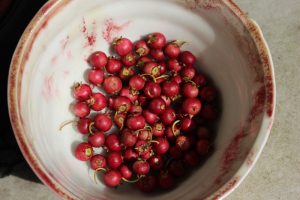
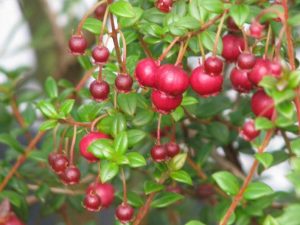 It also has received other formal botanical names, but the one used here (Ugni molinae)seems to be the best accepted one now. It is not native to New Zealand, and it is not a cranberry. It is a native of Chile, and part of the guava family of plants with edible fruits. These fruit are very small, brightly coloured when ripe, and with a distinctive, quite pleasant taste. Good to nibble on. Can be made into the usual sorts of things, as with other fruits of this general type, including jams. It’s a small, colourful shrub, and can also be found here in ornamental gardens, rather than fruit gardens. It ripens in early autumn
It also has received other formal botanical names, but the one used here (Ugni molinae)seems to be the best accepted one now. It is not native to New Zealand, and it is not a cranberry. It is a native of Chile, and part of the guava family of plants with edible fruits. These fruit are very small, brightly coloured when ripe, and with a distinctive, quite pleasant taste. Good to nibble on. Can be made into the usual sorts of things, as with other fruits of this general type, including jams. It’s a small, colourful shrub, and can also be found here in ornamental gardens, rather than fruit gardens. It ripens in early autumn
Price: $25
Vasconcellea cundinamarcensis (syn. Carica pubescens)
Mountain Pawpaw
More cold hardy than tropical papayas; and an ornamental subtropical too. People in NZ normally eat the soft seeds and juices from the seed cavity. Most don’t realize that it’s fine to eat the skins after a few minutes cooking in a very little water, and a bit of sugar to taste. Makes a fine topping for vanilla ice cream, or plain yoghurt.
Price: from $25 up
Vasconcellea goudotiana (syn. Carica goudotiana)
No common name
From highland tropical America.Red-orange-yellow fruits, a bit smaller than a mountain pawpaw (papaya), and much more red coloration in the leaf stems and veins. Ornamental, even without fruit. Can cook skins lightly with a little sugar to taste after discarding seeds.
Currently in stock.
Price: from $25, by size. Or 3 for $65. You need male and female plants, so 3 gives you a better chance of pollination.
Vasconcellea heilbornii ‘Babaco’
Babaco
A somewhat cool tolerant member of the papaya family with a mild-flavored, subacid large fruit. In fruit, an amazing sight for the subtropical garden.Babaco plants don’t have seeds, so I have to wait till I have further cuttings to start new plants. February 2023- a few in stock again.
Price: $30 and up, by size.

